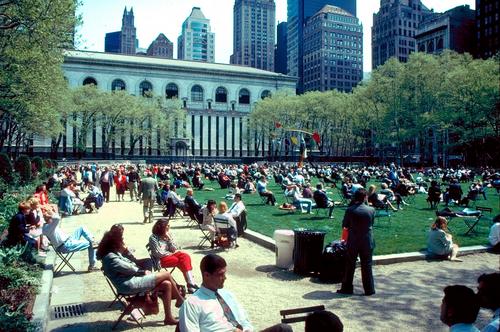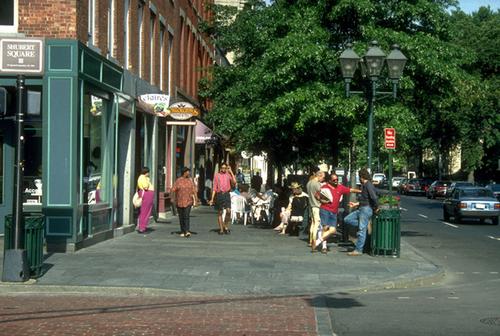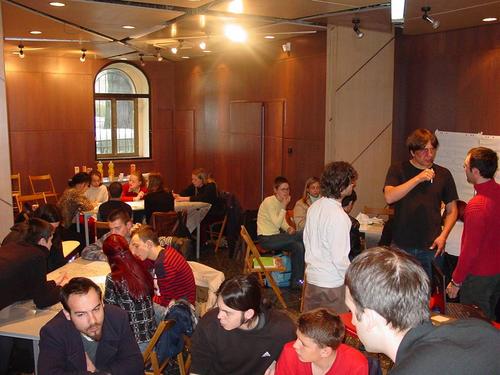A biweekly newsletter with public space news, resources, and opportunities.
A curated dispatch on all things public markets plus the latest announcements from the Market Cities Program.
Looking back over three decades of struggles, surprises and accomplishments, we are proud to highlight what we see as PPS's "Greatest Hits." In each case the impact or our work has reverberated far beyond the circumstances of the project itself. Indeed, each story outlined here became a turning point that spurred big changes, beginning with revelations about the nature of commercial public space that arose from our first experiences at Rockefeller Center, to our current work promoting public markets. Together these stories chronicle how far PPS has come, and offer a glimpse of how we'll continue to promote the ideas of Placemaking in the future.

In the early days, PPS spent a lot of time trying to convince developers and building managers that the presence of people in public spaces was nothing to fear. By fostering active spaces around their buildings, we emphasized, they would bolster the appeal of their properties. With some of our earliest projects, PPS proved that public spaces are valuable assets worthy of investment, as seen by the successful turnaround of Rockefeller Center's Channel Gardens and Exxon Mini-park. Today PPS is sought out by commercial developers eager to partner with us in providing active public spaces as part of their projects.
Success Story: Rockefeller Center, New York, NY (1975)
PPS transformed corporate wariness about public use of urban plazas, showing that with good management, these spaces could benefit businesses as well as the public

2. A New Vision for Parks as the Centerpiece of Communities
From the outset, PPS challenged the notion that city parks were simply passive, green refuges. We trumpeted the virtues of parks that accommodated a wide variety of public activities, from nature trails and sports fields to cafés and markets. Parks can serve as true community centers that spark the revitalization of neighboring districts. By pioneering the idea of public space management organizations -- which take charge of keeping parks clean, safe, and vital -- PPS helped introduce a new model for parks that cities around the world are still racing to copy. Bryant Park, once a drug market behind the New York Public Library, became a poster child of what was possible for urban parks.
Success Story: Bryant Park, New York, NY (1981)
PPS helped set the legendary turnaround of this midtown park in motion by creating destinations for people and establishing a well-funded, effective management structure

PPS has always considered lively Main Streets and urban commercial corridors as one of the most important ways of keeping towns and cities vital. Twenty five years ago we developed the first training materials for the National Main Street Center, and today we are working with communities from Littleton, New Hampshire to San Mateo, California, to improve local streets for pedestrians and businesses. All along, we have pursued a goal that looks beyond mere aesthetic trappings. To create a street where people want to hang out and patronize local businesses, you must make sure it is more than a thoroughfare for traffic. PPS has always focused on the ways you can transform a street into a place where people come first.
Success Story: Chapel Street, New Haven, CT (1983)
This New Haven business district is a prime example of how the Placemaking approach can revive an urban neighborhood...

Today, many communities are taking advantage of bus stops, light-rail transfer centers, and train stations as catalysts for revitalizing surrounding areas. This was not always the case. When PPS began its work on train stations in the early 90s, few transit agencies and local officials saw the potential of public transportation to create great places. One of the pioneers was New Jersey Transit, which asked PPS to help transform several train stations into vital public places that enhance the surrounding communities. Tom Downs, the director of New Jersey Transit, made the bold assertion that whatever could be seen from a station--looking in any direction--was the responsibility of the transit agency. He recognized that the success of public transit depended on people viewing the stations positively, accessing them comfortably, and finding other things to do besides waiting on the platform.
Since our initial work in New Jersey, PPS has taken this philosophy towards transit to California, New York, and many points in between. In fact, one of the earliest and most memorable examples of transit as a catalyst for Placemaking was created in Corpus Christi, Texas.
Success Story: City Hall Bus Transfer Center, Corpus Christi, TX (1991-1994)
PPS turned this transit center into an attractive place in itself, which attracts new riders by serving as a true community center...

In all the places where we work, from small towns in the heartland to big cities on the coasts, PPS is able to transcend the political differences that seem to divide America today. Discussing the potential for great public spaces is usually a unifying exercise for a community. And creating places where people of diverse backgrounds and beliefs can feel comfortable coming together is central to creating community and establishing thriving democratic institutions.
What really opened our eyes to the power of Placemaking as a democracy-building tool was the work we took on in the former Communist countries of Eastern Europe. By getting people involved in creating a brighter future for their public spaces, PPS introduced a powerful means to bridge differences and strengthen civil society in nations undergoing sweeping transformation.
Success Story: Placemaking in Eastern Europe (1993-present)
Starting in the Czech Republic, PPS has proven the power of Placemaking throughout Eastern Europe and the Balkans, helping to heal places scarred by violence, ethnic conflict, and dictatorship...

Urban parks can foster great neighborhoods when they are places where neighbors come together and social bonds are strengthened. Parks also offer measurable economic benefits, but it wasn't until recently they were recognized for the central role they play in urban revitalization. PPS marshaled research and resources to prove how urban parks contribute significantly to their communities.
Success Story: Establishment of the Urban Parks Institute (1995)
Through the Urban Parks Institute, PPS collected a unique library of park resources and increased awareness of the significant role parks play in community revitalization...

While funding for local parks programs has dropped in recent years, that hasn't stopped a number of cities from creating great new parks in the form of a classic public space: the civic square. From Anchorage, Alaska to Fort Worth, Texas to Greensboro, North Carolina, cities have revived the idea of public squares as opportunities to create lively gathering places in the heart of their communities. Local leaders now realize the need for public spaces where people can savor the experience of belonging to a distinct urban community, and they have succeeded in cultivating the support and funding to make this new breed of parks a reality. PPS led the way for rediscovering the civic square, and worked on creating one of the best examples with Detroit's recently completed Campus Martius Park.
Success Story: Campus Martius Park, Detroit (1999-2001)
PPS drew upon 25 years of experience in park design and management to help create this downtown square, which became an instant Detroit landmark...

8. Transforming Public Buildings into Community Places
Public buildings can be exciting as well as functional places--just look to the city halls of European cities like Paris, Vienna, and Stockholm for proof. But all too often they project a sense of dreariness and sterility. PPS has been committed to helping public buildings become lively community gathering spots since our start. We helped create a City Hall Plaza in Orlando full of public uses and played a role transforming New York City's Port Authority Bus Terminal from a dysfunctional den of sleaze to a bright haven for retail. We have worked with the American Library Association and Libraries for the Future to guide public libraries toward a more community-centered role in their communities, with lounges, "front porches," book stalls, and areas for public activity that complement the reading rooms and stacks.
Our efforts multiplied geometrically when the General Services Administration (GSA), an agency of the U.S. government which is responsible for federal properties across the country, asked us to advise its Public Buildings Service on how to create safe, attractive, and people-friendly public spaces in and around government properties. They wanted to capitalize on the potential of public buildings to foster lively public environments and strengthen surrounding downtown areas. Post offices, courthouses, and office buildings are all part of GSA's responsibility--and no matter the category, PPS has proved that underutilized public buildings can be turned into civic assets that strengthen the entire community.
Success Story: PPS Partnership with GSA's Good Neighbor Program (1999-present)
We have helped turn public buildings across the country into catalysts for downtown revitalization and development...

From the very start PPS has promoted the benefits of walkable communities and advocated the sort of pedestrian-friendly measures now known as traffic calming. But for many years our message was hard to hear above the roar of construction equipment widening roads and paving new highways across America. During this time, many commercial districts were decimated and thriving neighborhoods ruined when local streets were reengineered to become thoroughfares for thousands of speeding cars. People in many towns rose up to challenge this assault on their communities, but auto-happy traffic engineers and public officials often prevailed by invoking "progress" as a justification for the damage they did.
Then, about ten years ago, we began to notice a gradual but significant change. A more balanced approach to designing streets as places that takes in account the needs of people, transit, and cars, was gaining adherents among influential leaders at all levels in the transportation field. PPS has become a leading resource for local officials as well as state and federal agencies seeking to implement this enlightened approach to streets. Together with these key partners, we are ushering in a new era of transportation planning.
Success Story: A New Perspective for Traffic Engineers (2000-present)
Working with the New Jersey Department of Transportation, PPS trained hundreds of traffic engineers in the art of designing streets that fit with community goals...
PPS is best known for the dramatic changes we helped spur in places like Bryant Park in New York, downtown Corpus Christi in Texas, and Campus Martius in Detroit. As the organization matured, however, we've branched out to share lessons we've learned with the public as a whole. Our early efforts to spread the word about Placemaking--creating training materials for the National Main Street Center and sharing our park expertise in our publication User Analysis in Park Planning and Management--foreshadowed all the books, conferences, and training courses we have produced over the past ten years. All along, our aim has been to influence the future of the design, planning, and transportation disciplines by building a strong constituency of placemakers around the world.
Success Story: How to Turn a Place Around (2000-present)
PPS's signature book and training course have inspired people everywhere to make a difference in their own communities...

PPS's Public Markets program had an unusual beginning. It was 1984, and PPS President Fred Kent was stuck at a stultifying conference in Venice. Desperate to get outside and experience the city, Fred left the event with a group of friends, including long-time PPS board member Dana Crawford. After a few angry minutes discussing the conference, the group hunkered down to their own informal strategy session about the future of public spaces. No doubt inspired by many wonderful meals in the market laden Campos all over Venice, they arrived at the idea of public markets as social gathering places and engines of local economic growth.
At the time, the number of public markets remaining in America numbered in the hundreds. We set our sights on reversing this decline, launching the Public Market Collaborative in 1987. Led by PPS Vice President Steve Davies and Senior Associate David O'Neil, the program helped launch a dramatic renaissance: Today, over 5000 public and farmers markets have sprouted across the U.S., and hundreds of them have been helped through our research, training, conferences, and technical assistance programs. The revival has by no means peaked. Through our work with the Ford Foundation, PPS continues to explore new opportunities for public markets to enliven public life and revive local economies.
Success Story: Public Markets as Catalysts for Local Economic Revival (2002-present)
PPS research for the Ford Foundation is helping to make public markets a mainstream strategy for sensible economic development...
The rich text element allows you to create and format headings, paragraphs, blockquotes, images, and video all in one place instead of having to add and format them individually. Just double-click and easily create content.
The rich text element allows you to create and format headings, paragraphs, blockquotes, images, and video all in one place instead of having to add and format them individually. Just double-click and easily create content.
Body Text Body Link
The rich text element allows you to create and format headings, paragraphs, blockquotes, images, and video all in one place instead of having to add and format them individually. Just double-click and easily create content.
Here is some highlighted text from the article.




Headings, paragraphs, blockquotes, figures, images, and figure captions can all be styled after a class is added to the rich text element using the "When inside of" nested selector system.
Headings, paragraphs, blockquotes, figures, images, and figure captions can all be styled after a class is added to the rich text element using the "When inside of" nested selector system.
Headings, paragraphs, blockquotes, figures, images, and figure captions can all be styled after a class is added to the rich text element using the "When inside of" nested selector system.

We are committed to access to quality content that advances the placemaking cause—and your support makes that possible. If this article informed, inspired, or helped you, please consider making a quick donation. Every contribution helps!
Project for Public Spaces is a 501(c)(3) tax-exempt organization and your donation is tax-deductible within the guidelines of U.S. law.